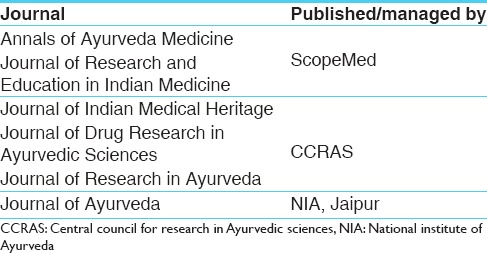Teaching from the time immemorial has been considered as a noble profession. Teaching, Research, and Publication are the three basic components (TRISTAMBHAS) that one need to take care in the system of education. Traditionally, new knowledge is disseminated through research papers published in peer-reviewed journals. Currently, peer-reviewed publications by the researchers are the measurable index of their performance. To showdown the credibility, an institution should have a good number of quality publications over a time scale. A good and responsible university will always reorient itself and generate good quality papers. Considering the impact of good publications in the field of science, certain universities such as Savitribai Phule Pune University has come out with a comprehensive policy on research publications, primarily to curb the growing tendency to publish papers in dubious and predatory journals, which, in turn, lowers the quality of research and affects the reputation of an institution.[1] Such stringent policies developed by Savitribai Phule University are needed in current times and all universities should come forward to take measures that curb academic pollution.
But, whether such policies will work in the field of Ayurveda? It is a difficult question to answer. Despite of larger investments in Ayurveda researches and a huge number of Ayurveda PG/PhD Scholars coming-out every year, they failed to publish the outcome because of many reasons. Lack of good journals to encourage Ayurveda research publications may be one of the reasons.
On the other hand, it is well known that professional advancement of a scientist can be obtained by publishing good quality research. The system of promotions in universities also depends on the papers published by an individual in an academic calendar. In such a scenario of publication driven promotions, annual appraisals, and lacking of Ayurveda journals, mushrooming of casual or spurious or predatory journals is witnessing. Such academic black market guarantees the researcher, a publication over the night. This ultimately produces a poorly taught generation, which is a serious concern to the society and to the science.
Current Scenario of Ayurveda Journals
Unfortunately, the scenario is discouraging. There are only few journals in the field of Ayurveda that understand and encourage Ayurveda concepts and researches. AYU managed by IPGT and RA Jamnagar, JAIM by the Institute of Ayurveda and Integrative Medicine, Bangalore, and ASL by The Ayurvedic Trust, Coimbatore are the only three Ayurveda journals indexed with PubMed and PubMed Central. Another journal, IJAR was started with great expectations, but was closed with certain administration wrangles. There are few more journals that exclusively encourage Ayurveda works [Table 1].
Table 1.
Few other journals that encourage Ayurveda works

In addition, certain journals such as Indian Journal of Natural Products and Resources, Indian Journal of Traditional Knowledge, and Journal of Scientific and Industrial Research of NISCAIR also support Ayurveda researches to some extent.
The scenario is pathetic and painful. There is a need to conduct training programs on research methodology, create awareness about predatory journals, and develop scientific writing skills to Ayurveda professionals.[2] On the other hand, there is no encouraging atmosphere for aspiring young researchers of Ayurveda. If enthusiastically someone wants to communicate their publications to foreign journals, they cannot meet the expenses.
In such situation, to uplift Ayurveda researches and publications, Ministry of AYUSH and other responsible authorities for AYUSH Education should think and take immediate actions to define a roadmap that will go ahead for a long. The two important issues that may help in uplifting the Ayurveda researches are:
Appointing Bio-statistician in all the Ayurveda research centers and Post Graduate education centers and hospitals
Establishing a PUBLICATION CELL at central level.
Undoubtedly, this step will uplift and disseminate Ayurveda potentialities throughout the world. The initiation should be focused on:
Primary Objectives
At the outset, have extended discussions with the scientific community to assess the requirement for new journals and establishing a publication cell
Identify potential individuals/agencies/universities/institutes that can be given the responsibility to manage journals
Fix number of journals and handover responsibilities
Appoint manpower and provide facilities
Organizing the journals punctually and periodically
To be certain that the contents of journals get into the abstracting and indexing journals
To improve citations for the publications (as high citations are always appreciated against publications in IF)
To decrease the time lag in between the acceptance of a paper and its publication.
Secondary
To reach-out to universities/students and inspire them. Discuss the reasons for the lack of good publications and restructure entire strategy to achieve this. Try to define and develop a smooth strategy, so that administration wrangles cannot come in the way of good research
Teach ethics to researchers and encourage young researchers and faculty to contribute
Must design a mechanism to assess the quality of publications while selecting best universities and institutions
Categorizing journals: Merely adding an adjective “National” or “Global” or “International” cannot qualify a journal to become truly international. There is a need to categorize journals for assessing the quality of publications
Keep a check on universities/individual institutions (annual reports of institutions focusing on publications) for grading/allotting funding to further researches, etc
Unfortunately, the education system of India in the present scenario is much considered about technical aspects and least preferred towards developing the communicating, writing, and publishing skills. It may be one of the reason, many scientists does not like to write or have poor writing skills.
This is the right time; that the Ministry of AYUSH come forward and take appropriate pro-active steps, design a strategy for optimum outcome in the area of research publications in Ayurveda.
References
- 1. [Last accessed on 2015 Sep 13]. Available from: http://www.epaperbeta.timesofindia.com/Article.aspx?eid=31814 and articlexml=Varsity-gives-policy-push-toresponsible-ethical-research_20052015004018 .
- 2.Patwardhan K, Galib R, Thakur P, Kumar S. Peer reviewed journals of Ayurveda – An appraisal. J Res Educ Indian Med. 2014;20:141–52. [Google Scholar]


